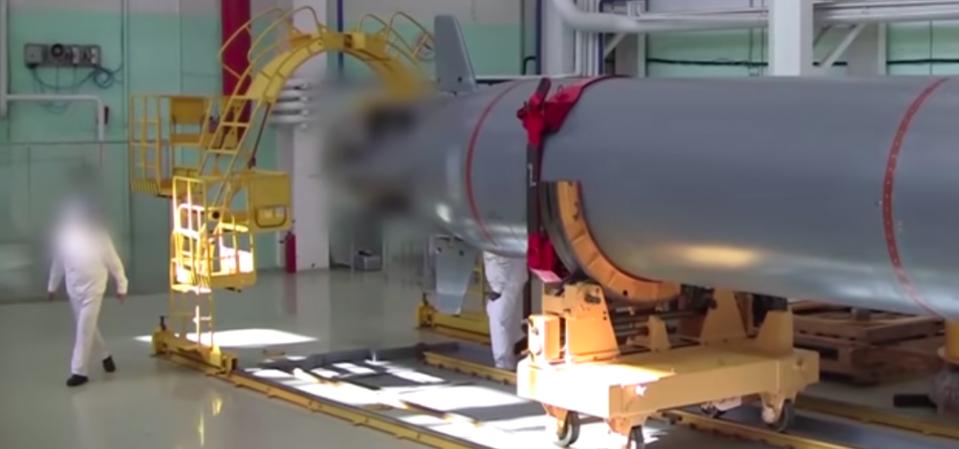Russia’s Dirty-Bomb Robo-Sub Is ‘Grotesque’—But Moscow’s Building A Base For It, Anyway

Poseidon
Russian defense ministry
Around five years ago, the regime of Russian President Vladimir Putin leaked secretive plans for a bizarre new doomsday weapon.
It was unclear at the time whether Poseidon—a huge, nuclear-tipped robotic submarine—was a real weapon or just the centerpiece of some weird propaganda scheme.
Today it’s increasingly clear that Poseidon not only is real, it’s something of a priority for the Kremlin. What’s less clear is exactly why Moscow thinks the “grotesque” doomsday robo-sub is a good idea.
Outside observers got their first glimpse of Poseidon in November 2015, during a television broadcast of a meeting between Putin and top military officials in the Black Sea city of Sochi.
A camera from government-owned Channel One captured a fleeting glance at a briefing book, in which were visible schematics for a 79-foot-long unmanned submarine packing a deadly radiological warhead.
The documents indicated that a larger, manned sub could function as a launch vehicle for Poseidon. After launch, the robo-sub would motor potentially hundreds of miles to its target then trigger its dirty-bomb.
“Purpose—the defeat of the important economic facilities in the area of the enemy coast and causing unacceptable damage to … the country through the establishment of extensive zones of radioactive contamination, unsuitable for implementation in these areas of military, economic, business or other activity for a long time,” Putin’s briefing read.
MORE FOR YOU
Experts at the time speculated that Poseidon might be an elaborate fiction. After all, the whole concept of a giant undersea robot irradiating an entire city is “grotesque and, objectively speaking, beyond unnecessary,” explained Kingston Reif, a nuclear expert with the Arms Control Association in Washington, D.C.
“The reported launch point (from a submarine close to the Russian mainland), target (U.S. coastal cities) and speed (60 to 100 knots) mean it could take the weapon approximately two days to reach its target,” Reif wrote in an email.
“The weapon’s speed and travel time is also likely to make it detectable—though still hard to defeat. Assuming Poseidon is ever actually fielded (and I have my doubts), what is the value of a weapon that takes this long to get to its target?”
He’s got a point. Who needs a slow, potentially vulnerable undersea dirty-bomb when you’ve got thousands of fast nuclear-tipped rockets that work perfectly well—and against which there are no reliable defenses?
But for all its conceptual flaws, Poseidon soon appeared in prototype form. It might be grotesque and unnecessary, but it also is real. Testing got underway in 2016. And now the Kremlin reportedly is planning to build a special base for as many as 30 Poseidons.
That doesn’t mean Poseidon actually is useful as anything more than a symbol, however. “I wouldn’t claim I understand the logic behind Poseidon,” said Pavel Podvig, an independent expert on the Russian military.
The logic might be entirely political, said Owen Cote, an expert on undersea warfare at the Massachusetts Institute of Technology. “I think the concept of operations is to create the illusion of something new and significant so as to burnish Russia’s image as one of only two nuclear superpowers in the world, which it is desperate to preserve,” Cote said.
“It is increasingly difficult for Russia to do this the old-fashioned way, by building lots of real weapons,” Cote added.
If appearances are the point, there’s a kind of perverse logic in developing outlandish weapons that, even if they don’t work, make a bold statement—and make that statement without requiring some huge industrial effort. Poseidon is real, but producing 30 of them hardly amounts to mass production. The robo-sub’s propaganda value very well could justify the few billion dollars it might end up costing.
Maybe the Kremlin truly believes Poseidon actually could play a meaningful role in some civilization-ending nuclear war. Or maybe the Kremlin just wants the world to think it’s crazy enough to believe that.
Pavel Luzin, a military expert at Perm University in Russia, proposed a third possibility. Maybe Poseidon is just a boring research submarine for unmanned deep-water experiments. But the Kremlin seized the opportunity to squeeze some propaganda value out of it by portraying it as a far-fetched weapon.
“I think Poseidon … is not a weapon itself, but it is aimed to be an essential part of Russia’s underwater forces,” Luzin said. “At the same time, Moscow creates a kind of ‘strategic fog’ when it speculates that Poseidon is a super-duper nuclear mega-torpedo.”
If that’s the case, Moscow is having its atomic cake and eating it, too. And somewhere in a Kremlin subbasement, some obscure mid-grade official in charge of submarine fiction is reading Americans’ scandalized reactions to Poseidon and enjoying a good, hearty laugh.
Whatever Poseidon is for, it’s looking increasingly likely that Russia is going to build of bunch of copies and a base to house them. Outside observers could spend decades watching the doomsday robo-subs and wondering—is the joke on them?
